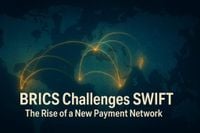It’s not every day that the world witnesses a seismic shift in the foundations of global finance, but that’s exactly what’s unfolding as the BRICS bloc—Brazil, Russia, India, China, and South Africa—moves closer to launching its own cross-border payment system, BRICS Pay. Unveiled at the 16th BRICS Summit in Kazan in 2024, this initiative is meant to reduce dependence on the U.S.-controlled SWIFT network, a system that has long been the backbone of international money transfers but is now facing its most serious challenge yet.
The motivation behind BRICS Pay is as much political as it is economic. According to TH, the project’s roots go back to the 2014 Fortaleza Summit, when member nations established the New Development Bank (NDB) and the Contingent Reserve Arrangement (CRA)—the first major financial institutions created by developing countries to rival Western-led entities like the IMF and World Bank. The urgency to build an alternative only intensified after Russia was hit by sweeping Western sanctions in 2014 and again following its 2022 invasion of Ukraine, which led to its exclusion from the SWIFT system. This vulnerability exposed how deeply global finance is entwined with geopolitical power, especially as exercised by the United States and the European Union.
BRICS Pay, as described by Watcher Guru, is designed to enable cross-border transactions in local currencies rather than U.S. dollars. This is a direct challenge to the dollar’s dominance and, in the eyes of many, a concrete step toward what’s been dubbed the de-dollarization movement. “The whole world started contemplating whether US dollars should be used since the United States, for political reasons, restricts the use of the US dollar as a universal international payment unit,” Russian President Vladimir Putin remarked, criticizing what he called the U.S. “weaponizing” the dollar.
Technically, BRICS Pay is ambitious. It seeks to connect the robust digital payment infrastructures that each member country already possesses—India’s UPI, China’s CIPS, Russia’s SPFS, Brazil’s Pix, and South Africa’s SAMOS—into a single interoperable platform. The prototype was demonstrated in Moscow in October 2024, and the system leverages a Decentralised Messaging System (DCMS) to ensure secure communications, along with a DAO governance model that promises equitable participation for all members, according to TH. The goal is not just to lower transaction costs and settlement times, but also to make global finance more inclusive and less susceptible to the whims of any single power.
Russia’s SPFS, for example, already boasts 159 foreign participants in 20 countries, and settlements with BRICS countries in national currencies have surged from 26% to 85% within just two years, as reported by Watcher Guru. This rapid shift underscores the appetite among emerging economies for alternatives to SWIFT, especially as U.S. sanctions continue to loom large over international commerce.
But the path to a fully operational BRICS Pay is riddled with challenges. The most immediate is technical: integrating five distinct payment systems, each with its own architecture, regulatory standards, and security protocols. As the Central Bank of Russia’s governor Elvira Nabiullina put it, “We are holding discussions on the interaction of such platforms, but here the interest and technical readiness of our partners are important.”
Then there are the divergent national ambitions. India, China, and Russia each have global aspirations for their own platforms—UPI, CIPS, and SPFS, respectively—which can lead to strategic overlap and friction. Political trust deficits, particularly between India and China, complicate consensus on governance. Meanwhile, the absence of a unified BRICS currency means that while local currency settlements are possible, seamless multilateral transactions remain a distant goal.
Western reaction to these developments has been swift and, at times, severe. Former U.S. President Donald Trump threatened 100% tariffs on BRICS members if they attempted to “create a new currency or back any other currency to replace the mighty U.S. dollar.” This kind of rhetoric highlights the geopolitical sensitivity of the move and the potential risks for early adopters of the new system.
Despite these hurdles, the BRICS Pay initiative is not about isolationism. Its architects insist that the goal is to diversify and democratize global finance, not to replace SWIFT outright. According to the Kazan Declaration, the intention is to “strengthen correspondent banking networks within BRICS and enable settlements in local currencies,” a sentiment echoed by the BRICS Business Council, which oversees the project. The system is designed to be fully compliant with international KYC and anti-money-laundering norms, aiming for global legitimacy and transparency.
What’s more, BRICS Pay aligns itself with broader sustainable development goals. By lowering transaction costs and enabling small and medium-sized enterprises to participate in cross-border trade, the system could help foster financial inclusion and innovation, supporting UN SDGs on poverty reduction and economic growth. The potential for blockchain-based auditing and AI-powered fraud detection also opens the door to indigenous fintech innovation across the BRICS bloc.
On the global stage, the stakes are high. If BRICS Pay succeeds, it could fundamentally alter the architecture of international finance, providing developing nations with a credible alternative to SWIFT and reducing the dollar’s overwhelming dominance. Even a regionalized adoption—focused on intra-BRICS trade, which already exceeds $600 billion annually—would signal a significant shift in the balance of economic power. As TH notes, the growing popularity of local currency settlements, especially in energy trade between India, Russia, and China, is already moving in this direction.
Yet, the ultimate success of BRICS Pay depends on more than just technology. It requires sustained political will, technical integration, and above all, trust among the members. The inclusion of Iran in BRICS in 2024, a country long targeted by Western sanctions, only underscores the bloc’s determination to build a sanctions-proof global payments system. But expanding the platform’s credibility beyond BRICS will require cooperation with neutral partners such as ASEAN, the African Union, and the Shanghai Cooperation Organization.
For now, the BRICS Pay story is one of cautious optimism. Incremental integration—starting with bilateral settlements and gradually scaling up—seems to be the strategy. Institutional backing from the New Development Bank and efforts to harmonize legal and technical standards under a proposed “BRICS Fintech Charter” are underway. The hope is to create a diversified technology stack that incorporates blockchain, AI, and cybersecurity, building the trust needed for a truly multipolar monetary order.
In essence, BRICS Pay is a bold experiment in financial sovereignty and global cooperation. Whether it becomes a global disruptor or remains a regional experiment will depend on the ability of its members to navigate the complex web of technical, political, and diplomatic challenges ahead. But one thing is clear: the era of unquestioned Western dominance in global finance is being challenged as never before.




